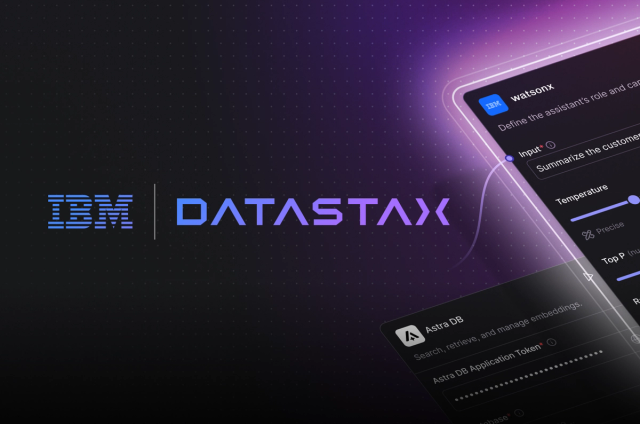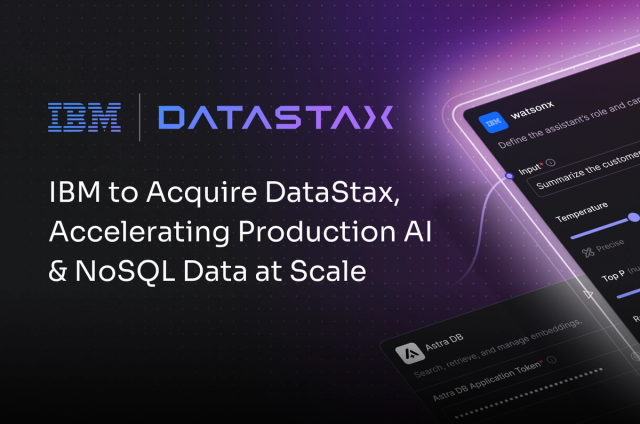Let's see how Cassandra's architecture and implementation stand up against top distributed NoSQL competitors—Couchbase, HBase, and MongoDB. After comparing these systems, you'll see why Cassandra is so popular with leading companies worldwide. And if you're looking for the best database built on Cassandra, consider using Astra DB—the fully managed, cloud-native solution that simplifies deployment and operations.
Apache Cassandra vs competitors
Evaluating NoSQL database performance requires a detailed comparison of architectural approaches and implementation strategies. This analysis breaks down Cassandra's technical capabilities by examining its design against key competitors MongoDB, HBase, and Couchbase.
NoSQL architecture
Cassandra incorporates several architectural best practices that impact performance. While these practices aren’t exclusive to Cassandra, Cassandra is the only NoSQL system that incorporates all of them.
Fully distributed
Every Cassandra node handles a proportionate share of every activity in the system. Unlike systems that rely on special cases like Hbase’s Hadoop Distributed File System (HDFS)NameNode, MongoDB Mongo Atlas, or the MySQL Fabric Process, in Cassandra’s masterless design, every node is the same.
This continuity simplifies installation and operations, and makes troubleshooting easier. Even when everything works perfectly, parent/child designs have a bottleneck at the master. With no single point of failure, Cassandra delivers lower latency and uninterrupted uptime.
Log-structured storage engine
Cassandra’s log-structured storage engine avoids overwrites, turning updates into sequential I/O. This log-structured storage is essential for hard disks (HDD), due to high seek penalties, as well as solid-state disks (SSD), to avoid write amplification and disk failure. In contrast, MongoDB’s performance drops significantly as the dataset size exceeds available RAM. Alternatively, Couchbase's append-only B-trees avoid overwrites, but require several searches when updating or inserting new documents and do not support durable writes without a significant performance penalty.
Locally-managed storage
HBase has an integrated, log-structured storage engine, but relies on HDFS for replication instead of managing storage locally. That means HBase is architecturally incapable of supporting Cassandra-style optimizations like putting the commitlog on a separate disk, mixing SSD and HDD in a single cluster with appropriate data pinned to each, or incrementally pulling compacted SSTables into the page cache.
Prepared statements
The Cassandra Query Language allows Cassandra to pre-parse and re-use query plans, reducing overhead. Others remain stuck with primitive JSON APIs or even raw Java Scanner objects. CQL also allows Cassandra to express more sophisticated operations like lightweight transactions with a minimal impact on clients, resulting in wide support across many programming languages. The closest alternative is Apache Phoenix, a Java-only SQL layer for HBase.
NoSQL implementation
An architecture is only as good as its implementation. Every release was a learning experience for the first years after Cassandra's open-source release. Versions 0.3, 0.4, 0.5, and 0.6 each attracted a new wave of users that exposed some previously unimportant weaknesses.
Today, Cassandra has thousands of production deployments, the most for any scalable database. With Astra DB, you get this technology delivered as a fully managed service, reducing operational overhead while ensuring enterprise-grade performance and scalability.
Common methods of implementing a NoSQL database
When comparing each NoSQL database option, we considered the three most common use cases for implementation:
-
New applications: Building a new application from the ground up with NoSQL, avoiding legacy system limitations such as application rewrites and data migrations.
-
Augmentation: Adding a NoSQL component to an existing system. Augmentation occurs when applications outgrow traditional relational databases, often because of scaling problems, a need for better availability, or a transition to hybrid/cloud environments.
-
Full database replacement: Replacing an outdated relational database system that is proving too costly to keep, or that can no longer scale effectively to handle increases of user concurrency, data velocity, or data volume.
Apache Cassandra vs MongoDB
While MongoDB can be a great alternative to MySQL, it doesn’t scale as effectively as Cassandra for distributed applications. Let’s look at some key differences between the two:
Updates
Database-level locking limits MongoDB, meaning only one writer can modify a database at a time. Despite support for collection-level locking and MongoDB’s collections (a set of documents, analogous to a relational table), a small number of writes can still lead to stalls in read performance for "hot" tables.
In contrast, Cassandra uses advanced concurrent structures to provide high-performance updates without locking. Cassandra even eliminates the need for locking during index updates.
Additionally, when adding or updating a field in a MongoDB document, users must rewrite the entire document. If you preallocate space for each document, you can avoid the associated fragmentation.
Even with preallocation, however, update speeds slow down as documents grow. Cassandra's storage engine, on the other hand, only appends updated data and never rewrites or rereads existing data. That means updates to a Cassandra row or partition stay fast, even as your dataset grows.
Replication
MongoDB's replication is complex and fragile due to its reliance on a primary-secondary model for data consistency. While MongoDB makes it easy to set up replication, it can lead to issues such as the emergence of multiple primary nodes within the same shard. This situation occurs when failover mechanisms or network partitioning glitches cause the system to lose track of the true primary, resulting in both nodes accepting writes, which creates data conflicts and inconsistencies.
Although the automatic failover process should promote a secondary node to the primary if the original master goes down, problems can arise if systems don’t properly synchronize or if network conditions delay communication between them. As a result, users may encounter conflicting data written to different nodes, complicating recovery and data integrity.
Alternatively, Cassandra’s architecture features a smoother failover and automatic repair, which helps better manage network partitions and node failures, ensuring data integrity across the system even in distributed environments.
Apache Cassandra vs HBase
HBase's storage engine is the most similar to Cassandra's. Both draw on Bigtable's early design. Today, Cassandra's storage engine outperforms HBase's. This elevated performance is because Apache built HBase on HDFS instead of using locally-managed storage, which adds complexity and reduces performance.
Cassandra leads in solid state drive support and efficient use of the page cache for large datasets. HBase relies on HDFS for storage, introduces extra layers of complexity, and can lead to increased latency.
These drawbacks make it less efficient at optimizing I/O operations than Cassandra’s locally managed storage. On the other hand, Cassandra leverages a log-structured storage engine that supports high-speed SSDs and uses the page cache efficiently, ensuring consistent performance as data volumes grow.
Cassandra's replication design is also inherently better suited for delivering low-latency response times, while also tolerating failures. HBase uses a primary-secondary replication model that, although capable of automatic failover, may experience delays and increased latency during recovery events.
Cassandra’s masterless architecture also has smooth failover and rapid automatic repair, which minimizes latency and ensures data integrity even during node failures or network partitions.
Cassandra is a leader in developer productivity, providing CQL, which offers a more intuitive interface than HBase’s difficult-to-use column family model. Additionally, while Cassandra can support hundreds of tables without issue, HBase tends to struggle with more than two or three column families, limiting its scalability and flexibility.
Apache Cassandra vs Couchbase
Couchbase presents a document-based data model to the end user, but under the hood, it maps everything to a key/value storage API. Like MongoDB, updating any field in a document requires rewriting the whole thing.
Like MongoDB, Couchbase performs asynchronous writes by default. This asynchronous writing means that, after performing a Couchbase put operation, it buffers the data in memory but not on disk. This is why naive Couchbase benchmarks post such startling performance numbers. Couchbase can force persist writes to disk, but doing so kills performance. Since there is no commitlog or journaling, each write must update Couchbase's B-tree and fsync.
Couchbase's storage engine has trouble dealing with more than five buckets (which are analogous to relational tables). The suggested workaround is to create a type attribute that will help you differentiate the various objects stored in a single bucket.
Couchbase's replication is simpler than MongoDB's, but still lacks rigor in its design. Couchbase is neither entirely consistent nor fully available, and it cannot serve reads during failover or network partitions. However, it can still serve stale data during those events.
Couchbase nominally supports active/active cross-datacenter replication, but if users update the same document concurrently in both, they will lose one of the updates. These replication failures often require manual intervention to recover.
Cassandra avoids this issue entirely, handling cross-datacenter replication by merging updates at the column level and, optionally, using lightweight transactions to enforce a linearizable operation order.
Conclusion: Apache Cassandra is the clear winner
When you take a close look at Cassandra's architecture and implementation, its advantages over other top NoSQL databases become clear. Whether it’s distribution, storage, queries, scaling, updates, or replication, Cassandra excels in every aspect.
For a hassle-free, fully managed Cassandra experience, Astra DB is the ideal choice. It offers all the power of Cassandra with the simplicity of a cloud-native service, eliminating the need for complex setups or ongoing maintenance.
See how Apache Cassandra and Astra DB can help your company.
Learn more about NoSQL & Apache Cassandra
-
Explore our hub page: What is NoSQL? Non-Relational Databases Explained
-
Check out our blog post on The Evolution of NoSQL
-
Download the whitepaper: Benchmarking Top NoSQL Databases
FAQs
1. What are the best Apache Cassandra alternatives for NoSQL databases?
Some widely used Apache Cassandra alternatives include MongoDB, Apache HBase, Couchbase, and ScyllaDB. Each offers different trade-offs in scalability, performance, and transactional consistency, making them suitable for different big data workloads.
2. How does Apache Cassandra compare to other NoSQL databases?
Compared to other databases, Cassandra is a distributed NoSQL system designed for seamless scalability and high availability. Unlike MongoDB, which uses a document model, Cassandra is a columnar database optimized for high throughput and low-latency queries at a large scale.
3. Is Cassandra a good choice for real-time analytics?
Yes, Cassandra is widely used for real-time analytics due to its high volume read and write capabilities, making it ideal for big data workloads. Its distributed architecture allows for fast ad hoc queries across multiple nodes without sacrificing performance.
4. Does Cassandra support SQL-like queries?
Cassandra uses Cassandra Query Language (CQL), which is similar to SQL but optimized for scalable NoSQL databases. While it lacks full Atomicity, Consistency, Isolation, and Durability (ACID) transactions, CQL supports efficient use of queries across distributed clusters with tunable consistency levels.
5. How does Cassandra handle scalability compared to a fully managed database service?
Unlike fully managed services such as Google Bigtable or AWS DynamoDB, Cassandra allows organizations to scale horizontally by adding more nodes while maintaining low latency and high availability. However, maintenance and infrastructure management require more hands-on effort than fully managed NoSQL solutions. For those choosing the open-source Cassandra route, DataStax Luna offers robust support, while those looking for a fully managed solution can turn to Astra DB.









